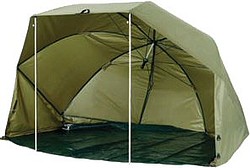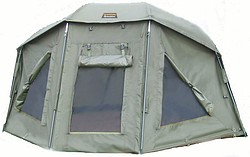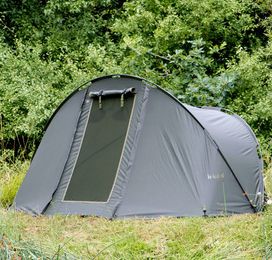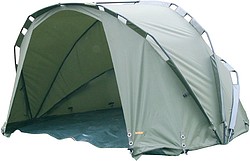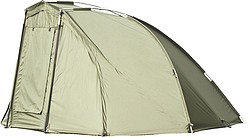Looking for a brolly shelter, but not sure where to start? Hardly surprising to be honest, there are so many types available, all of which seemingly offer endless advantages over the next, that it can all become a bit daunting. Not to worry, however, we’ve put together this handy guide to help you suss out the benefits of each type available in order that you can find a brolly shelter that’s perfectly suited to your needs.
First off, we need to explain exactly what a brolly shelter is. A brolly shelter is designed to be a lightweight system which can be carried, moved, set up and broken down really easily. Its purpose is to offer the angler a versatile form of shelter without all the frills. Traditionally, the brolly shelter was aimed at the short stay angler doing quick overnighters without barrows and such like, so it was all about function – providing just enough shelter to get by and keep the angler with a small amount of tackle protected.
However, the brolly shelter now appeals to many anglers who may be staying at the lake for several nights, but who like to remain mobile throughout the length of their session and, as such, the design of brolly style shelters has evolved greatly. Traditionally, a brolly was pretty much an extended oval version of an umbrella with an internal framework which popped open when opened up just like an umbrella. The brolly shaft could then be removed and a boss inserted to keep it open. This system was quick and simple, and remained untouched for years. However, one problem with this type of system is the lack of head room due to the internal rib-frame design, which was effectively like having your head stuck up in the top of an umbrella in-between the ribs.
The advent of the pram hood bivvy brought about a whole new wave of newly designed lightweight shelters aimed at the brolly angler, and so whilst some of the current brolly shelters don’t actually have a brolly design, they offer increased levels of space (due to an external framework) yet remain just as easy to erect and transport, and thus are still classed as lightweight brolly shelters or brolly domes.
Additionally, advancements with the old internal brolly design by Aqua and Trakker saw the framework moved to the outside of the shelter, which increased space and improved the stability. As such, there are now a whole host of brolly style bivvies to choose from, but more on those later.
The traditional oval brolly is still among the cheapest of shelters available. They have extended sides to aid protection and in most cases can be pegged with the fronts at two heights, allowing it to hunker down a little more in poor weather. Because the internal ribs are lightweight, an oval brolly can get blown around a little bit, so most tend to use them from spring through to autumn. Fishing an open fronted brolly on an exposed swim during winter in windy conditions would not be advised generally, as you might find it somewhere else in the morning!
That said, there are a number of extras you can get for a brolly system including side bars, front bars and over wraps, all of which will aid stability and allow it to be used in harsher conditions. I’m a big fan of the old style oval brollies, and have used them myself extensively over the years. They are versatile, lightweight, and can be set up or broken down in a minute. Transportation is also extremely easy as they will slip straight into a rod bag or quiver.
There are various extras you can get (many of which come as standard) with oval brollies including groundsheets, front panels with windows and roll up and removable doors, and even full winter wraps. All these extras only add to the versatility of the oval brolly and allow the angler to simply take the extras required to cater for the conditions at hand.
There are a few downsides to an oval brolly, though. Firstly, the lack of headroom, as mentioned previously. Many old school anglers just kind of got used to this, the advantages far outweighed the disadvantages, but now with a new breed of shelters available offering better use of space, you do need to consider the other alternatives. Also, some of the brollies can leave you a little exposed from the sides, so if you are set up in a crosswind or driving rain, you may be left a little exposed if you have no front on. Lastly, they are not as stable in harsh conditions as the newer pram hood shelters and can get blown about in blustery conditions, though, as stated, they are fantastically easy to use and, for many, the benefits during summer use far outweigh any disadvantages.
So, on to the pram hood shelters. These are effectively stripped out pram hood bivvies, aimed at the short stay or mobile angler. The first and most obvious advantage is the increased space available, mainly because this type of system utilises an external frame so there is no shortage of space internally. Additionally, because all pram hood designs start pegged out at the back and are secured in an ‘up and over’ fashion, you have much better protection so will not be left exposed at the sides like you might be with an oval brolly – furthermore, many have wrap around front skirts to aid protection even further.
Rigidity is much improved, too. Rather than having thin ribs, most brolly shelters or domes utilise hollow frame bars, which are opened out and slotted together to give excellent stability. Some even offer additional tensioning poles which fit between the bars to increase stability even more, and thus you could fish into harsher conditions in relative comfort each year with greater ease than you could with an oval brolly.
Again, there are a whole host of extras available with pram hood shelters which allow the angler infinite variations to suit their needs and the conditions they are likely to be faced with, so check what’s included in the deal in terms of ground sheets, support bars, wraps, etc.
Downsides? Well, as you might suspect, weight can be one. Due to their robust design they can weigh a little more than an oval brolly, and due to the way they are put up and taken down by un-jointing the frame and folding up into sections, they can take longer to put up and break down. Likewise, once packed away they can’t be slipped into a quiver or rod bag quite as easily as a brolly, and thus the real decision between the two comes down to your intended use…
If you want increased stability and greater levels of comfort, and can sacrifice a little with regard to versatility, ease of use and transportation, then steer towards the shelters. If the opposite applies and you want a system that gives easy use and transportation, will go up and come down quickly, then go for a brolly system.
As mentioned earlier, there are also a few systems available using external frames in a traditional brolly design, however, these would usually be classed as bivvies due to their vastly improved features taking them out of the quick-shelter price band. However, they are worth a mention as they offer the best of both worlds in terms of stability, comfort and ease of use – the downside being that you are paying for the privilege.
I personally use a Trakker Pioneer Ultralite, which follows the principles of brolly design but has an external aero grade frame to offer better strength and stability. The Trakker Crossfire is another shelter designed to appeal to both camps and has proved popular with many specimen anglers, but either design would set you back over twice what you’d expect to pay for a good brolly system with all the extras.
Ultimately, it’s a case of weighing up the pros and cons of either a brolly or pram hood shelter, or having the best of both worlds and paying a bit more by going for a higher spec bivvy system. Either way, I’ve highlighted a few options well worth looking at;
Daiwa Mission Overnighter
The Daiwa Mission Overnighter is, effectively, an oval brolly with a detachable groundsheet (with a wrap available as an extra). The design oozes simplicity and usability. There are no gimmicky features or needless innovations; it does exactly what it says on the tin, providing excellent levels of protection at an extremely favourable price.
- Supplied with detachable groundsheet
- Manufactured from extra durable PU coated nylon
- Perfect for overnight sessions or the roving angler
- The Daiwa Mission Overnighter is lightweight, yet extremely stable
Verdict – We love it. A no nonsense carp fishing shelter that offers real value for money. Lightweight, yet robust, it’s the perfect companion for those doing regular overnighters who like to travel light.
Available from: Fishtec
Priced at: £59.99
CLICK HERE FOR MORE INFORMATION
Trakker Specimen Brolly Bivvy
Durability, strength and ease of use; just some of the reasons the Trakker brolley has been held in the highest regard for many years by specimen anglers. Sometimes, you just want a value for money purchase that’s straight forward with no messing around, and given such requirements, you’d have to say the Trakker Specimen Brolly Bivvy is the perfect choice.
- The Trakker Specimen Brolly Bivvy has a deluxe infill panel with mozzi windows/door
- 2 x 26″ storm poles
- 2 x 48″ storm poles
- Groundsheet
- 16 x quality ‘T’ pegs
- 4 x storm caps
- Supplied with a carry case
Verdict – A firm favourite out on the banks, the Trakker Specimen Brolly is truly versatile and adaptable. It stands up well to the elements and is extremely easy to use. Highly rated.
Available from: Fishtec
Priced at: £169.99
CLICK HERE FOR MORE INFORMATION
Nash H-Gun Strongbow Bivvy
As entry-level ranges go, the H-Gun range from Nash Tackle is about as good as it gets – and the Strongbow bivvy is a perfect example, offering rock solid performance at a value for money price.
The Nash H-Gun Strongbow bivvy is a serious bit of kit which offers more cover, protection and strength than a traditional brolly, yet retains some of their much-loved elements including a speedy setup and rapid breakdown. The frame system is the ever-popular pram hood with extra heavy-duty, flexible fibreglass poles. Set-up time is double quick. The Strongbow can genuinely be set up in a minute or less. Once the poles are located and flexed and the bivvy is pegged securely, the whole structure becomes super rigid.
The Strongbow is capable of withstanding gale force winds and monsoon like storms. The skin is heavy-duty for long term waterproofing and durability. It also features zip-able panels to expose mosquito windows, a rear mesh vent to enhance airflow, a storm window and a removable groundsheet.
- Revolutionary, rapid setup frame.
- Manufactured to last, utilising heavy-duty 100% waterproof PU nylon.
- Long lasting heavy-duty zips and reinforced pegging points.
- Front waterproof zip-able panel to expose mosquito windows and storm door.
- Rear vents to enhance air-flow and comfort.
- Supplied with : Removable groundsheet, Nash heavy-duty T pegs, & Carry case
Verdict
In a market flooded with cheap bivvies, the Nash H-Gun Strongbow is a serious contender. OK, it’s never going to trouble its established big brothers like the Titan, but for those just getting into the sport or for those on a tight budget, the Strongbow is the perfect choice.
Available From: Sportfish
Priced at: £122.99
CLICK HERE FOR MORE INFORMATION
Trakker A-Lite Bivvy
The Trakker A-Lite shelter is a robust alternative to a brolly system, which benefits from having no internal rib system to compromise space. It’s an ideal short session shelter that can quickly convert to a bivvy system with the addition of the optional A-Lite wrap.
- Three pole system enabling ultra quick erection
- Packs down in to a brolly pouch
- Complete with groundsheet, frame support and heavy duty pegs
Technical Specifications
- Material: 4oz Nylon
- Dimensions: 2.8 m x 2.2
- Transport Size: 150 x 20 x 20cm
Verdict – There’s no doubt a brolly is the fastest type of shelter to set up, but it can leave little sheltered space for tackle and with minimal headroom for the angler. The A-Lite offers a lightweight alternative, providing all the shelter and protection you need for quick overnighters, but with comfort built in.
Available From: Sportfish and Fishtec
PriceD at: £129.99
CLICK HERE FOR FISHTEC
CLICK HERE FOR SPORTFISH
Trakker Crossfire Bivvy
The Crossfire’s fresh new design provides a lightweight alternative to pram hood bivvies and offers more protection than a conventional brolly or shelter thanks to its external frame support.
The Trakker Crossfire Bivvy is ideal for overnighters and quick sessions and has proved a huge hit for the mobile angler moving from swim to swim. Clever cross-tensioned Aerograde aluminium flexi-poles with no metal junction blocks make for an ultra-stable, lightweight bivvy that packs down to a manageable size for easy transportation in even the smallest of quivers, and the now legendary Aquatexx® Fabric skin provides total protection from the elements.
- Aquatexx® zip off panel on separate zip
- Mozzy zip off front panel
- ‘T’ pegs
- Groundsheet
- Zipped carry bag
- 2 x 48in Stormpoles
- Material: Aquatexx
- Weight: 4.5kg (All bivvy weights are shown less groundsheet and pegs totalling 3kg)
- Dimensions : 3.3 m x 2.3 m
- Transport Size : 175 x 20 x 20cm
- Door Height : 110cm
- Bivvy Height : 140cms
Verdict – For us, the Crossfire sits somewhere between the Aqualite and the Armo. It’s perhaps more sturdy than the Aqualite, but not as nimble or as fast to set up, yet on the other hand, it’s not as cumbersome as the Armo. As such, it’s ideal for the overnight or short stay angler who wants that extra protection but without all the extra weight!
Available From: Sportfish and Fishtec
Priced from: £350.00
CLICK HERE FOR FISHTEC
CLICK HERE FOR SPORTFISH
Julian Grattidge
February 2011
PRICES CORRECT AT TIME OF PUBLICATION
